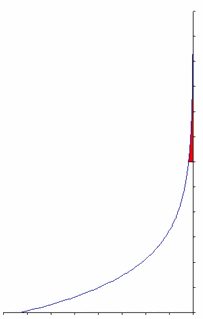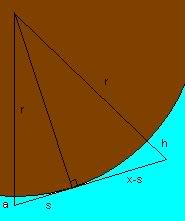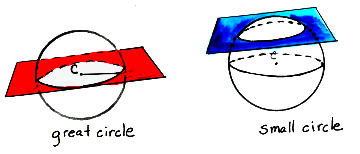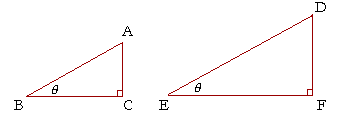Most of these calculations are wrong. See post on last page.
Given the FE map shown above, I'm assuming the diameter of the equator is generally accepted as 12800 Km (
same as a RE equator) (how does one estimate the diameter of an imaginary circle on a unknown flat surface?
measuring the Earth). Now, because there is never any quantifiable evidence given, I will again assume that the distance from the equator to the "ice wall" is half of the diameter of the equator, or 6400 Km. That makes the diameter of the FE aprox. 25600 Km.
There are some interesting results of geometry between the FE and RE:
Area of a sphere is (where r = 12800 Km)
4 * pi * r^2 =
2.06 E9 Km^2
Area of a circle is (where r = 25600 Km)
pi * r^2 =
2.06 E9 Km^2In either model Earth has the exact same area (given the assumptions above). However,
Area of the northern circle (FE) is
pi * r^2 =
0.514 E9 Km^2 (where r = 12800 Km)
Area of the southern "ring" (FE) is
pi * r^2 - (northern circle) =
1.544 E9 Km (where r - 25600 Km)
Whereas the area of a hemisphere (RE) is
2*3.14159*(12800_Km)^2 =
1.03 E9 Km^2Does this change the relative sizes of the north and south continents/oceans? It definitely does between these two models, but who has actually measured them? The government? Probably not, because all they want is our money! (for some reason)
Now, areas are hard to qualify because they are so large (and we are so small), but distances and flight times are very easy to understand.
Take the geodesic (shortest distance between two points on the surface of a sphere) between, say, Auckland, New Zealand and Santiago, Chile. Having looked up a flight from Auckland, NZ to Santiago, Chile, it would take
11:20 , or 11.33 hours (if the link doesn't work look it up your damn self; took me forever) to fly a RE distance of
9690 Km . That makes a flight speed estimate: 9690Km / 11.33 h = 855 Kph (even if I assume 30 minutes total runway taxi time, that makes flight speed 895 Kph, which is closer to the 880 Kph max efficiency speed of the
Airbus 340, the plane listed in the flight itinerary).
To find the FE distance between the two cities, I will assume the latitude and longitude are the same between the two models (as is apparent on the above map) so I can simply find the
distance distance between two polar coordinates on a flat surface.
Santiago:Because the latitude 33.47 is South from the Equator, add 90 degrees to reference the north pole. Then multiply by 12800 Km per 180 degrees to get distance in Km.
r1=(33.47+90)*12800/180 = 8780.09 Km (radial distance from north pole)
theta1=-70.75 = -70.75 degrees (from prime meridian)
Auckland:r2=(36.87+90)*12800/180 = 9021.87 Km
theta2=174.8 = 174.8 degrees
Planar distance between Auckland and Santiago:
r1^2 + r2^2 - 2*r1*r2*Cos[theta1 - theta2] =
4460.19 KmSurprisingly, the FE distance is less than half the RE distance! I thought it would be larger because of the greater area of the southern "ring". Keep in mind that these distances by no means follow the same path over the surface of the Earth, though. Whereas the bearing from Auckland is
Southeast on the RE, it is Northeast on the FE map.
Remember that flight time of 11.33 hours?
4460 Km / 11.33 h = 394 Kph
This is only 100Kph higher than
take-off speed for the Airbus 340. Or perhaps the airline wastes the following amount of hours:
11.33_h - 4460_Km / 880_Kph = 6.3 hours
That's a lot of time lost. The airlines, pilots, and passengers must be in on the conspiracy.
The same results are found in the northern hemisphere, too. The distance between New York and London is shorter for the FE model:
5585 Km on a RE4066 Km on a FE (using the same calculation as above, except this time subtracting the latitude from 90 in order to reference the north pole as origin)
That's about a 25% shorter distance.
My Final Thought:
Just like Intelligent Design, the
Flying Spaghetti Monster, UFO's, 9/11, gravity, the big bang, quantum mechanics, and on and on, there is no way to truly "know" anything. All we can do is pick the best abstraction or estimation that fits what we observe, actually has testable hypotheses, and yields new predictions of other events. If anything, I think the Flat Earth idea is clinging on to the absence of information and evidence about our world and calling that void a viable theory. If you've actually read the
Flat Earth Society official website it is very seriously a joke feeding on a fundamental misunderstanding of the theories on which a Round Earth model is built (for example: Argument Three - The impossibilities of holding unsecured objects in place on a curved surface.
source)
I'm not calling anyone names, nor do I plan to. I believe the Earth is round because of the mounds of other sciences that go hand-in-hand (like astrophysics, geology, etc.) and I do not think there is substantial evidence to believe in an alternative, though it is interesting to play with other ideas. In the words of Richard Feynman: Why do you care what anyone else thinks? Stop thinking and get your ass out there and do something about it if you truly do believe in it.














